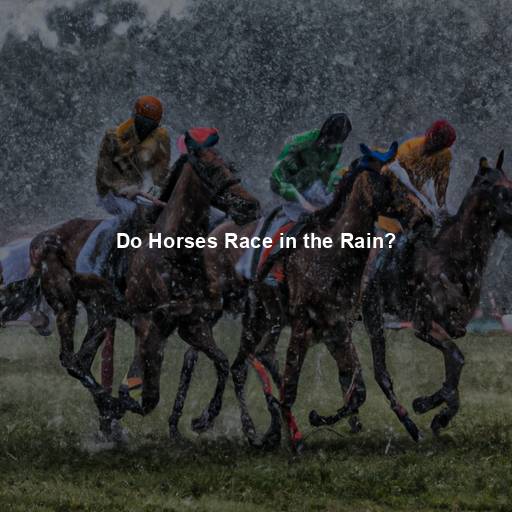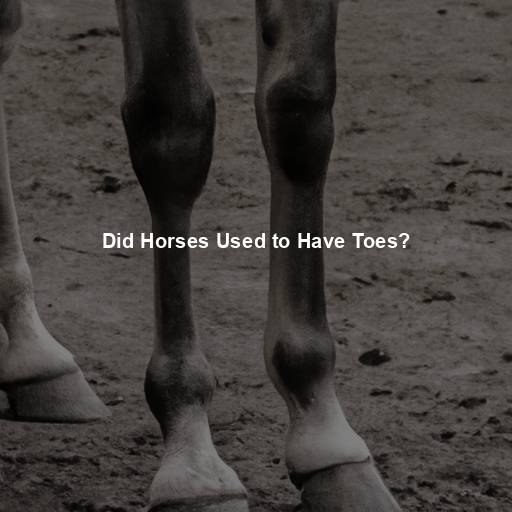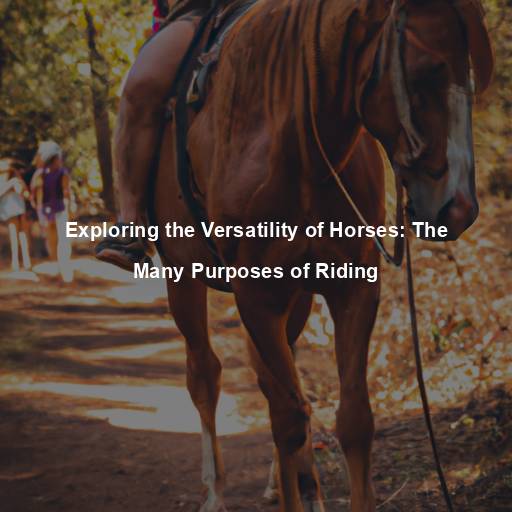Do Horses Race in the Rain?
Last Updated on November 7, 2023 by Evan
Contents
- 1
- 2 The Track Conditions
- 3 The Impact on Horse Performance
- 4 Safety Considerations
- 5 Track Preparation
- 6 Weather Forecast and Race Decisions
- 7 Historical Examples
- 8 The Emotional Connection
- 9 The Spectator Experience
- 10 Ensuring Safety and Fairness
- 11 Appreciating the Equine Athletes
- 12 FAQs: Do Horses Race in the Rain
- 12.1 Can horses race in the rain?
- 12.2 How does rain affect horse racing?
- 12.3 Do horse races ever get canceled due to rain?
- 12.4 Are there any special precautions taken when horses race in the rain?
- 12.5 Are there any specific horse breeds that perform better in rainy races?
- 12.6 How can spectators enjoy horse racing in the rain?
For centuries, the sport of horse racing has enthralled and captivated audiences, inducing a magical sense of awe. As we witness these remarkable creatures galloping down the track, their speed and agility leave us breathless. But, amidst this exhilarating spectacle, a perplexing question arises – do horses race in the rain? In this article, we will embark on a fascinating journey into the enigmatic realm of horse racing, unraveling the intricate web of factors that determine whether a race can flourish under wet conditions.
The Sport of Horse Racing
Horse racing has a rich history dating back thousands of years. It is a sport that combines the beauty of horses with the excitement of competition. From the ancient civilizations of Greece and Rome to the modern-day racetracks around the world, horse racing has remained a beloved pastime.
The Impact of Weather
Weather conditions play a significant role in horse racing. While races are typically held under clear skies, the weather can sometimes take an unexpected turn. Rain, in particular, poses unique challenges for both horses and jockeys. It can affect the track surface, horse performance, and even the safety of the participants.
The Track Conditions
The Role of Track Maintenance
Before we delve into the impact of rain on horse racing, it’s crucial to understand the different types of track surfaces and their maintenance. Racetracks can be made of dirt, turf, or synthetic materials, each with its own set of characteristics. Track maintenance teams work tirelessly to ensure that the surface is safe and optimal for racing.
Rain and Track Surface
As droplets of rain grace the hallowed racetrack, a dance between nature and sport ensues. The transformation is tangible, as earthy dirt tracks turn into enigmatic mires, mystifying the steeds that dare to conquer them. In a parallel realm, the once pristine turf succumbs to a watery embrace, its lushness tinged with sinewy vulnerability. Yet amidst this perplexing metamorphosis, the synthetic tracks stand steadfast, their innovative drainage systems beckoning horses to glide upon a more benevolent canvas of destiny.
The Impact on Horse Performance
The Weight Factor
When it comes to racing in rainy conditions, there’s a peculiar challenge that keeps both jockeys and horses on their toes – the pesky burden of added weight. Rain-soaked tracks tend to embrace these majestic creatures, leaving their hooves carrying the unwanted load of mud and water. Alas, this unwelcome baggage can play tricks on their performance, potentially impairing their speed and agility during the race.
The Slippery Surface
When the rain pours and the track gets drenched, it becomes a treacherous battlefield for horses and jockeys alike. The once seamless surface morphs into a slick danger zone, where slips and falls lurk at every turn, just waiting to shatter bones and dreams. Jockeys, brave souls atop their noble steeds, must tap into their inner caution and recalibrate their riding strategies to navigate this slippery labyrinth. The horses, magnificent creatures of muscle and grace, must also adapt their strides, seeking stability amidst the chaos to ward off calamities that could spell disaster for all involved.
The Visibility Factor
Rain can also impact visibility during a race. Heavy downpours can obscure the jockey’s view, making it harder for them to assess their position in the race and make strategic decisions. Reduced visibility adds another layer of complexity to an already demanding sport.
Safety Considerations
The Welfare of the Horses
When it comes to horse racing, there’s no horsing around when it comes to the safety and well-being of these majestic creatures. As raindrops fall from the heavens, a touch of perplexity fills the air, giving rise to concerns about the potential hazards that lie ahead. However, fear not, for the racing authorities and track officials take a firm grip on the reins, closely watching the ever-changing weather conditions to ensure a smooth and secure ride for both horses and jockeys alike.
Track Inspections
When it comes to hosting a race, there’s more to it than just the adrenaline rush and cheering crowds. The behind-the-scenes work is a dance of inspections, evaluations, and calculations. Track officials, the unsung heroes, scrutinize every inch of the track – its firmness, how well it handles water, and whether it lives up to safety standards. Mother Nature’s unpredictable moods can throw a wrench in the plans, forcing tough decisions like postponing or even canceling races to prioritize the well-being of those involved.
Expert Riding Skills
Jockeys, those skilled athletes of the equine realm, possess an ethereal finesse that holds a perplexing allure. In the intricate world of horse racing, their mastery of riding becomes a symphony, harmonizing with every beat of the hoof. Amidst the capricious rain-drenched tracks, their dexterity emerges as a clandestine dance, requiring unwavering balance, sublime agility, and an innate grasp of their horse’s unfathomable essence.
Adjusting Riding Techniques
When racing in the rain, jockeys need to adapt their riding techniques to accommodate the challenging conditions. They must carefully gauge their horse’s stride and adjust their weight distribution to maintain balance on the slippery track. Expert jockeys know how to navigate the turns and make split-second decisions to ensure a competitive edge.
Track Preparation
Track Drainage Systems
When it comes to racing in the rain, the ability of modern racetracks to cope with excess water is crucial. These tracks have smart drainage systems in place, designed to swiftly remove any unwanted rainwater from the surface. Such systems play a pivotal role in determining whether racing is viable amidst wet weather conditions.
Sand and Fiber Additives
In some cases, racetracks utilize sand and fiber additives to enhance the track’s stability and drainage capabilities. These additives can help prevent excessive mud accumulation and create a more consistent racing surface even in wet conditions. The use of such additives allows for safer and more efficient racing, even when rain is present.
Weather Forecast and Race Decisions
Monitoring Weather Conditions
As race day approaches, organizers diligently keep their eyes on the ever-shifting skies, constantly scanning weather reports with a mix of anticipation and trepidation. These valuable insights provide them with a glimpse into the mysterious whims of Mother Nature, allowing them to weave a intricate tapestry of race scheduling, all while safeguarding the wellbeing of those involved. Striving for that delicate equilibrium between preserving the purity of the sport and ensuring the welfare of each brave participant, they navigate through the unpredictable terrain of atmospheric uncertainty.
Race Postponements and Cancellations
When Mother Nature decides to unleash her torrential downpours or other unfavorable weather conditions, race officials face the perplexing task of assessing whether to postpone or cancel races. With the horses’ and jockeys’ welfare at stake, along with the need to maintain a level playing field, these decisions are not taken lightly. While race enthusiasts may experience a surge of disappointment, it is imperative to embrace these measures as a means of minimizing risks and safeguarding everyone involved.
Historical Examples
Famous Rainy Races
Over the course of time, there have been captivating moments that arose when horse races coincided with the unpredictable downpour from the heavens. In the annals of racing history, the 1978 Belmont Stakes stands as a testament to the unwavering spirit and fortitude displayed by the illustrious horses and their intrepid jockeys. As Affirmed and Alydar engaged in an intense duel amidst the relentless rain, an indelible memory of equine prowess was etched into the collective consciousness of all who witnessed it.
Memorable Comebacks
In some cases, racing in the rain has led to remarkable comebacks and surprising outcomes. The challenging conditions can level the playing field and introduce an element of unpredictability. Horses that may have been considered underdogs in ideal weather conditions can showcase their true potential and achieve unexpected victories.
The Emotional Connection
The Beauty of Nature
There is an inexplicable allure in observing the majestic dance of horses, their thundering hooves creating a symphony on rain-soaked tracks. The intertwining of strength and elegance amidst the cascading droplets invokes a profound sense of wonder and reverence for the natural world. It is a mesmerizing spectacle that illuminates the unwavering tenacity and grace embodied by these awe-inspiring beings.
The Resilience of Horses
One can’t help but marvel at the incredible strength and remarkable adaptability of horses. Their ability to race in the pouring rain adds a whole new layer of admiration to their already awe-inspiring qualities. It’s a true testament to their innate athleticism and the profound connection they share with their skilled jockeys, who entrust these majestic creatures to maneuver the treacherous track with grace and precision amidst the challenging circumstances.
Unpredictable Outcomes
Racing in the rain adds an element of unpredictability to the sport. The challenging conditions can level the playing field and create opportunities for underdogs to shine. Horses that may have struggled in ideal weather conditions can find their stride and surprise everyone with their performance. This unpredictability keeps spectators on the edge of their seats, eagerly awaiting the outcome of each race.
Embracing Adversity
There’s something truly captivating about witnessing horses and jockeys navigating through the unpredictable chaos of adverse weather conditions. It’s as if Mother Nature herself has decided to put their skills to the ultimate test, challenging their adaptability and resilience. In these moments, what shines through is not just their physical abilities, but the unwavering bond between horse and rider, and the sheer determination that drives them to conquer the impossible. It’s a true marvel to witness these magnificent animals embrace the chaos and emerge as champions of the storm.
The Spectator Experience
The Drama of Rainy Races
There’s something undeniably mesmerizing about witnessing a horse race unfold amidst a cascading downpour. The sheer power and magnificence of the charging horses, galloping through a track soaked with rain, creates a captivating spectacle that seizes the imagination. With each droplet that plummets onto the racing grounds, the stakes soar higher, amplifying the emotions that swirl within the spectators, and engulfing them in a perplexing yet exhilarating ambiance that only such an extraordinary event can deliver.
Connecting with Nature
There is an inexplicable allure to dashing through the rain, where the poetry of existence unfolds amidst the chaos. The rhythmic symphony of hoofbeats mingling with the gentle pitter-patter of raindrops creates an enchanting concerto that resonates deep within our souls. In this tempestuous performance, the equine elegance takes center stage, their glistening mane and vibrant coats serving as vibrant brushstrokes on nature’s masterpiece. Racing in the rain, an ethereal amalgamation of vigor and serenity, invites us to immerse ourselves in the symbiotic dance between beasts and the untamed realm they call home.
Ensuring Safety and Fairness
Track Inspections and Safety Measures
At the heart of every race, safety takes the reins and gallops ahead. Track officials leave no stone unturned as they meticulously examine every nook and cranny of the racecourse, untangling the perplexities that could hamper the smooth flow of action. From the solidity of the ground to the efficiency of the drainage systems, every inch is inspected, leaving no room for chance or unpredictability. Their unwavering commitment to ensuring the well-being of both horses and jockeys weaves a tapestry of anticipation, sprinkled with moments of uncertainty and triumph.
Fair Competition
Maintaining fairness in horse racing is essential, regardless of the weather conditions. When racing in the rain, track officials strive to create an even playing field for all horses. This may involve adjusting race distances or postponing races to allow for better track conditions. The goal is to ensure that each horse has an equal opportunity to showcase its abilities and compete fairly.
Appreciating the Equine Athletes
The Majesty of Horses
Horses hold a special place in our hearts, captivating us with their elegance and strength. Racing in the rain highlights their incredible athleticism and adaptability. It allows us to witness firsthand the grace and power with which they navigate challenging conditions, leaving us in awe of their natural abilities.
An Unbreakable Bond
The intricate relationship shared between horses and jockeys transcends mere collaboration, delving into the realms of trust, reverence, and a profound understanding. The very essence of this alliance is fortified when they embark on the adrenaline-fueled pursuit of racing amidst a cascading deluge. Amidst the watery chaos, both steed and rider are enigmatically united, relying on one another’s instincts and synchrony to gracefully navigate the treacherous terrain. This enigmatic cohesion serves as a poignant testament to the profound emotional and physical connection that unites them in harmonious perplexity.
FAQs: Do Horses Race in the Rain
Can horses race in the rain?
Race day is a tumultuous affair, where equine athletes face the unpredictable forces of nature head-on. Rain, a formidable companion, often graces the racing scene, bringing with it a torrent of uncertainty. These noble creatures, trained to withstand the whims of the elements, press forward, battling the deluge with unwavering determination. It must be noted though, in extreme cases when Mother Nature unleashes her full fury, races may find themselves reluctantly postponed or cancelled to safeguard the well-being of all involved.
How does rain affect horse racing?
When it comes to horse racing, Mother Nature’s unpredictable rain showers can really throw a wrench into the mix, leaving jockeys and horses perplexed. The slick, muddy tracks that result from the downpour give these majestic creatures a challenging obstacle to tackle, testing their balance and performance. While some horses may find their stride in these damp conditions, others may struggle to gallop through the wet surface. As if that wasn’t enough, jockeys must also navigate the race with reduced visibility, adding an extra layer of burstiness to this already perplexing sport.
Do horse races ever get canceled due to rain?
In the thrilling world of horse racing, the unexpected can manifest itself in the form of unpredictable weather patterns. Just like the energy and spirit that permeate the racetrack, the safety of all involved – be it the awe-inspiring horses, the daring jockeys, or the cheering spectators – is an absolute priority. As such, race organizers carefully scrutinize the atmospheric intricacies, ready to make swift decisions should the track become perilous or visibility be shrouded in uncertainty. Ultimately, these precautionary measures ensure that the pulse-pounding races can proceed seamlessly, all while protecting the wellbeing of those immersed in this captivating sport.
Are there any special precautions taken when horses race in the rain?
When horses race in rainy conditions, certain precautions may be taken to ensure the safety and welfare of the horses. Race organizers may adjust the distance or timing of races, depending on the severity of the rain. Additionally, jockeys may change their racing tactics to account for the slippery surface. Horses may also be equipped with appropriate hoof protection to provide better traction on wet tracks.
Are there any specific horse breeds that perform better in rainy races?
When it comes to rainy races, there’s no one-size-fits-all horse breed that takes the crown. It’s a wild, unpredictable world out there, and every horse has its own quirks and capabilities when faced with downpour. While some equine gems may dance gracefully through the raindrops, others might find themselves stumbling on the wet track. Seasoned horse trainers and jockeys, aware of these individual nuances, carefully select the races that suit each horse’s peculiar preferences and abilities.
How can spectators enjoy horse racing in the rain?
Experience the thrill of horse racing even in the midst of a drizzle! Don’t let a little rain dampen your spirits – just make sure you’re prepared. Dress for the weather with waterproof gear, grab an umbrella or raincoat, and get ready to cheer on your favorite horses. Stay up-to-date with the race schedule, keeping in mind that weather conditions may prompt last-minute changes. And don’t forget to keep an eye on the track conditions, as they can add a dash of unpredictability to the races.







